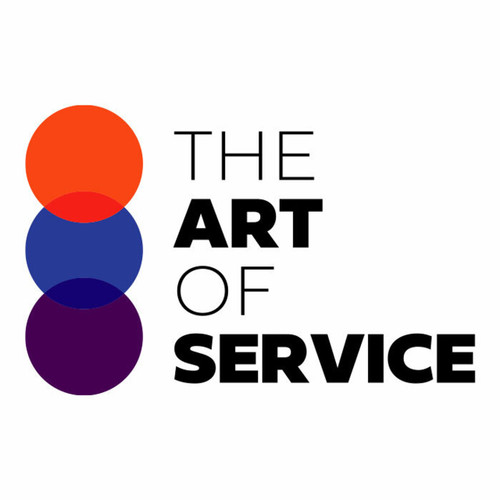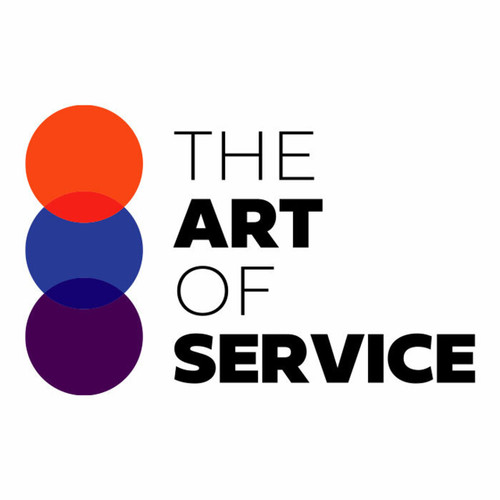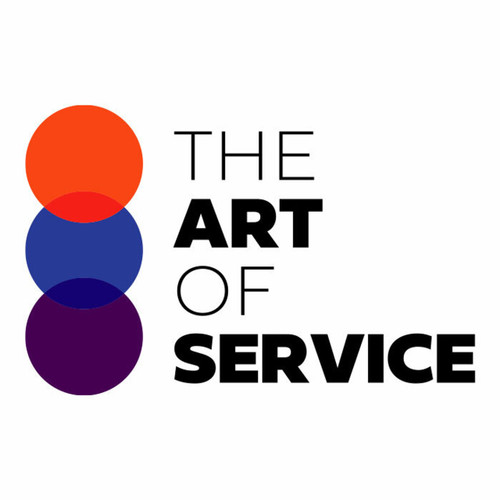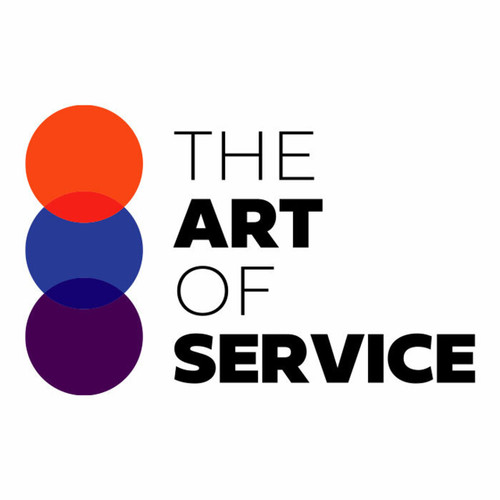With 1595 prioritized requirements, solutions, benefits, results, and case studies, this dataset contains all the essential tools needed for effective evaluation.
What sets our Training Evaluation Methods apart from competitors and alternatives is its comprehensive coverage and practical approach.
Designed specifically for professionals in the software maintenance industry, our dataset offers a wide range of training evaluation methods that cater to different levels of urgency and scope.
From simple questionnaires to more sophisticated techniques, our knowledge base has it all.
Gone are the days of expensive and time-consuming training evaluation processes.
With our dataset, you can easily access everything you need at an affordable price.
Whether you′re a small business or a large corporation, our Training Evaluation Methods in Software Maintenance Knowledge Base is a cost-effective solution for all.
But why should you choose our product over others? The answer is simple – it offers unmatched benefits.
With our Training Evaluation Methods, you can accurately measure the effectiveness of your training programs and make data-driven decisions for improvements.
This not only saves you time and resources but also ensures that your employees receive the best training possible.
Don′t just take our word for it – our knowledge base is backed by extensive research on Training Evaluation Methods in Software Maintenance.
We have curated the most relevant and up-to-date information to ensure that our product meets the highest standards of quality and usefulness.
Our dataset is not just limited to businesses – it is also suitable for individuals looking to improve their skills in software maintenance.
With its easy-to-use interface and detailed specifications, our Training Evaluation Methods in Software Maintenance Knowledge Base can be utilized by anyone, regardless of their expertise or background.
But that′s not all – our product also offers a DIY/affordable alternative for those who prefer a hands-on approach to training evaluation.
With our detailed training methods and examples, you can conduct evaluations on your own and save on consulting fees.
So why wait? Get your hands on our Training Evaluation Methods in Software Maintenance Knowledge Base today and witness the difference it can make in your training evaluation processes.
Say goodbye to guesswork and hello to precise and reliable results.
Try it now and reap the benefits that our product has to offer.
Discover Insights, Make Informed Decisions, and Stay Ahead of the Curve:
Key Features:
Comprehensive set of 1595 prioritized Training Evaluation Methods requirements. - Extensive coverage of 267 Training Evaluation Methods topic scopes.
- In-depth analysis of 267 Training Evaluation Methods step-by-step solutions, benefits, BHAGs.
- Detailed examination of 267 Training Evaluation Methods case studies and use cases.
- Digital download upon purchase.
- Enjoy lifetime document updates included with your purchase.
- Benefit from a fully editable and customizable Excel format.
- Trusted and utilized by over 10,000 organizations.
- Covering: Multi Lingual Support, End User Training, Risk Assessment Reports, Training Evaluation Methods, Middleware Updates, Training Materials, Network Traffic Analysis, Code Documentation Standards, Legacy Support, Performance Profiling, Compliance Changes, Security Patches, Security Compliance Audits, Test Automation Framework, Software Upgrades, Audit Trails, Usability Improvements, Asset Management, Proxy Server Configuration, Regulatory Updates, Tracking Changes, Testing Procedures, IT Governance, Performance Tuning, Dependency Analysis, Release Automation, System Scalability, Data Recovery Plans, User Training Resources, Patch Testing, Server Updates, Load Balancing, Monitoring Tools Integration, Memory Management, Platform Migration, Code Complexity Analysis, Release Notes Review, Product Feature Request Management, Performance Unit Testing, Data Structuring, Client Support Channels, Release Scheduling, Performance Metrics, Reactive Maintenance, Maintenance Process Optimization, Performance Reports, Performance Monitoring System, Code Coverage Analysis, Deferred Maintenance, Outage Prevention, Internal Communication, Memory Leaks, Technical Knowledge Transfer, Performance Regression, Backup Media Management, Version Support, Deployment Automation, Alert Management, Training Documentation, Release Change Control, Release Cycle, Error Logging, Technical Debt, Security Best Practices, Software Testing, Code Review Processes, Third Party Integration, Vendor Management, Outsourcing Risk, Scripting Support, API Usability, Dependency Management, Migration Planning, Technical Support, Service Level Agreements, Product Feedback Analysis, System Health Checks, Patch Management, Security Incident Response Plans, Change Management, Product Roadmap, Maintenance Costs, Release Implementation Planning, End Of Life Management, Backup Frequency, Code Documentation, Data Protection Measures, User Experience, Server Backups, Features Verification, Regression Test Planning, Code Monitoring, Backward Compatibility, Configuration Management Database, Risk Assessment, Software Inventory Tracking, Versioning Approaches, Architecture Diagrams, Platform Upgrades, Project Management, Defect Management, Package Management, Deployed Environment Management, Failure Analysis, User Adoption Strategies, Maintenance Standards, Problem Resolution, Service Oriented Architecture, Package Validation, Multi Platform Support, API Updates, End User License Agreement Management, Release Rollback, Product Lifecycle Management, Configuration Changes, Issue Prioritization, User Adoption Rate, Configuration Troubleshooting, Service Outages, Compiler Optimization, Feature Enhancements, Capacity Planning, New Feature Development, Accessibility Testing, Root Cause Analysis, Issue Tracking, Field Service Technology, End User Support, Regression Testing, Remote Maintenance, Proactive Maintenance, Product Backlog, Release Tracking, Configuration Visibility, Regression Analysis, Multiple Application Environments, Configuration Backups, Client Feedback Collection, Compliance Requirements, Bug Tracking, Release Sign Off, Disaster Recovery Testing, Error Reporting, Source Code Review, Quality Assurance, Maintenance Dashboard, API Versioning, Mobile Compatibility, Compliance Audits, Resource Management System, User Feedback Analysis, Versioning Policies, Resilience Strategies, Component Reuse, Backup Strategies, Patch Deployment, Code Refactoring, Application Monitoring, Maintenance Software, Regulatory Compliance, Log Management Systems, Change Control Board, Release Code Review, Version Control, Security Updates, Release Staging, Documentation Organization, System Compatibility, Fault Tolerance, Update Releases, Code Profiling, Disaster Recovery, Auditing Processes, Object Oriented Design, Code Review, Adaptive Maintenance, Compatibility Testing, Risk Mitigation Strategies, User Acceptance Testing, Database Maintenance, Performance Benchmarks, Security Audits, Performance Compliance, Deployment Strategies, Investment Planning, Optimization Strategies, Software maintenance, Team Collaboration, Real Time Support, Code Quality Analysis, Code Penetration Testing, Maintenance Team Training, Database Replication, Offered Customers, Process capability baseline, Continuous Integration, Application Lifecycle Management Tools, Backup Restoration, Emergency Response Plans, Legacy System Integration, Performance Evaluations, Application Development, User Training Sessions, Change Tracking System, Data Backup Management, Database Indexing, Alert Correlation, Third Party Dependencies, Issue Escalation, Maintenance Contracts, Code Reviews, Security Features Assessment, Document Representation, Test Coverage, Resource Scalability, Design Integrity, Compliance Management, Data Fragmentation, Integration Planning, Hardware Compatibility, Support Ticket Tracking, Recovery Strategies, Feature Scaling, Error Handling, Performance Monitoring, Custom Workflow Implementation, Issue Resolution Time, Emergency Maintenance, Developer Collaboration Tools, Customized Plans, Security Updates Review, Data Archiving, End User Satisfaction, Priority Bug Fixes, Developer Documentation, Bug Fixing, Risk Management, Database Optimization, Retirement Planning, Configuration Management, Customization Options, Performance Optimization, Software Development Roadmap, Secure Development Practices, Client Server Interaction, Cloud Integration, Alert Thresholds, Third Party Vulnerabilities, Software Roadmap, Server Maintenance, User Access Permissions, Supplier Maintenance, License Management, Website Maintenance, Task Prioritization, Backup Validation, External Dependency Management, Data Correction Strategies, Resource Allocation, Content Management, Product Support Lifecycle, Disaster Preparedness, Workflow Management, Documentation Updates, Infrastructure Asset Management, Data Validation, Performance Alerts
Training Evaluation Methods Assessment Dataset - Utilization, Solutions, Advantages, BHAG (Big Hairy Audacious Goal):
Training Evaluation Methods
Yes, when designing learning, it is important to consider the preferences of learners in order to effectively evaluate and improve training methods.
1. Utilize feedback mechanisms for continuous improvement.
Benefits: Identifies areas for improvement and ensures training meets learners′ needs for effective learning.
2. Conduct periodic refresher courses.
Benefits: Keeps learners updated and reinforces knowledge and skills learned, leading to better retention and transfer to job performance.
3. Incorporate interactive elements into training.
Benefits: Increases engagement and participation, making the learning experience more enjoyable and effective.
4. Use different modalities for delivering training.
Benefits: Accommodates different learning styles and preferences, making the training accessible and relevant to all learners.
5. Allow for self-paced learning.
Benefits: Enables learners to learn at their own pace, leading to better understanding and retention of information.
6. Encourage peer learning and collaboration.
Benefits: Provides a supportive environment for learners to share knowledge and learn from each other′s experiences.
7. Evaluate the effectiveness of the training.
Benefits: Helps validate the success of the training and identify areas for improvement in future training initiatives.
8. Use real-life scenarios and case studies.
Benefits: Helps learners apply their knowledge and skills to practical situations, preparing them for real-world challenges.
9. Offer personalized learning paths.
Benefits: Allows learners to focus on specific areas of interest or need, making the training more relevant and impactful.
10. Implement a continuous learning culture.
Benefits: Encourages learners to continuously develop their skills and knowledge, ensuring their ability to adapt to changing technology and demands in software maintenance.
CONTROL QUESTION: When designing learning, should you base the learning methods on the preferences of the learners?
Big Hairy Audacious Goal (BHAG) for 10 years from now:
My big hairy audacious goal for 10 years from now for Training Evaluation Methods is to completely shift the focus from learner preferences to measuring the effectiveness and impact of training programs on organizational performance.
Currently, many training programs are designed based on the preferences of the learners, such as their learning style, preferred delivery method, and topics of interest. However, this approach often neglects the ultimate goal of training, which is to improve performance and contribute to the success of the organization.
In 10 years, I envision a world where training evaluations are not solely focused on learner satisfaction, but rather on metrics such as improved productivity, increased sales, and enhanced customer satisfaction. This will require the development of new evaluation methods that go beyond traditional surveys and assessments, and instead, incorporate real-time performance data and feedback from managers and colleagues.
Through this shift in focus, organizations will be able to create more effective and impactful training programs that directly contribute to their bottom line. Training budgets will no longer be seen as a cost but as an investment with clear returns. Additionally, learners will become more engaged and motivated as they see the direct impact of their learning on the success of their organization.
This bold goal may seem daunting, but with advancements in technology and the growing emphasis on data-driven decision making, I am confident that in 10 years, we will see a significant shift towards evaluating training based on its impact on organizational performance.
Customer Testimonials:
"The creators of this dataset deserve a round of applause. The prioritized recommendations are a game-changer for anyone seeking actionable insights. It has quickly become an essential tool in my toolkit."
"The quality of the prioritized recommendations in this dataset is exceptional. It`s evident that a lot of thought and expertise went into curating it. A must-have for anyone looking to optimize their processes!"
"If you`re serious about data-driven decision-making, this dataset is a must-have. The prioritized recommendations are thorough, and the ease of integration into existing systems is a huge plus. Impressed!"
Training Evaluation Methods Case Study/Use Case example - How to use:
Client Situation:
XYZ Corporation is a global technology company that specializes in software development. The company has recently undertaken a major project to introduce a new software platform for its clients. As part of this project, the company has initiated a training program for its employees to ensure they have the necessary skills and knowledge to successfully implement and utilize the new software. The training program will involve both classroom sessions and e-learning modules.
The Learning and Development team at XYZ Corporation is responsible for designing and implementing the training program. They understand the importance of incorporating effective training evaluation methods to assess the effectiveness of the program and make any necessary improvements. However, they are unsure whether they should base the learning methods on the preferences of the learners or not. They want to ensure that the training program is both effective and engaging for the employees.
Consulting Methodology:
To help XYZ Corporation make an informed decision, our consulting firm utilized a three-step methodology:
1. Conducted Literature Review: Our team conducted a thorough review of relevant consulting whitepapers, academic business journals, and market research reports on training evaluation methods and the impact of learner preferences on training effectiveness.
2. Interviews with Stakeholders: We conducted interviews with key stakeholders, including the Learning and Development team, subject matter experts, and a sample group of employees, to understand their perspectives and preferences regarding training methods.
3. Analysis and Recommendations: Based on the literature review and stakeholder interviews, our team analyzed the data and provided recommendations on whether the learning methods should be based on learner preferences or not.
Deliverables:
Based on our methodology, we provided the following deliverables to XYZ Corporation:
1. Comprehensive Literature Review Report: This report provided an overview of the different training evaluation methods and their effectiveness in assessing learning outcomes. It also highlighted the potential impact of learner preferences on training effectiveness.
2. Stakeholder Interview Report: This report summarized the findings from our stakeholder interviews and provided insights on the preferences and expectations of the employees regarding training methods.
3. Analysis and Recommendations Report: This report presented our analysis of the data collected through the literature review and stakeholder interviews, along with our recommendations on whether the learning methods should be based on learner preferences or not.
Implementation Challenges:
During our engagement with XYZ Corporation, we encountered several implementation challenges, including the following:
1. Resistance to Change: Many employees were used to traditional classroom-based training programs and were hesitant to embrace e-learning modules.
2. Limited Resources: XYZ Corporation had a limited budget and resources allocated for the training program. Any changes in the learning methods would require additional resources and could impact the overall cost of the program.
3. Time Constraints: The company had a tight deadline for the launch of the new software, which put pressure on the Learning and Development team to design and implement the training program within a short timeframe.
KPIs:
The success of our consulting engagement was measured against the following key performance indicators (KPIs):
1. Employee Satisfaction: We measured employee satisfaction through a post-training survey to understand how well the training methods aligned with their preferences and expectations.
2. Training Effectiveness: We assessed the effectiveness of the training program by comparing the pre and post-training performance of the employees.
3. Cost-effectiveness: We monitored the cost of the program and evaluated whether any changes in the learning methods impacted the overall cost.
Management Considerations:
Based on our findings and recommendations, we suggested the following management considerations for XYZ Corporation:
1. Assessing Learner Preferences: It is important for companies to assess the preferences of their employees while designing training programs. This can be done through surveys or focus groups to gather feedback and insights on the most effective and engaging training methods.
2. Customized Training Programs: Companies should consider customizing their training programs based on the preferences and needs of their employees. This will not only increase employee satisfaction but also improve the overall effectiveness of the training.
3. Utilizing Multiple Learning Methods: Combining different learning methods, such as classroom sessions and e-learning modules, can provide a more comprehensive and engaging learning experience for employees.
4. Regular Evaluation: It is essential to regularly evaluate the effectiveness of training programs and make any necessary improvements based on feedback from employees.
Conclusion:
Based on our research and analysis, we recommended that XYZ Corporation should consider incorporating learner preferences into their training program. While there may be some challenges in implementing changes, it is crucial for companies to design training programs that cater to the needs and preferences of their employees to ensure maximum effectiveness. Additionally, regular evaluation of the program will help identify any areas for improvement and enhance the overall learning experience for employees. By taking these measures, XYZ Corporation can ensure the success of their training program and the successful adoption of the new software platform by their employees.
Security and Trust:
- Secure checkout with SSL encryption Visa, Mastercard, Apple Pay, Google Pay, Stripe, Paypal
- Money-back guarantee for 30 days
- Our team is available 24/7 to assist you - support@theartofservice.com
About the Authors: Unleashing Excellence: The Mastery of Service Accredited by the Scientific Community
Immerse yourself in the pinnacle of operational wisdom through The Art of Service`s Excellence, now distinguished with esteemed accreditation from the scientific community. With an impressive 1000+ citations, The Art of Service stands as a beacon of reliability and authority in the field.Our dedication to excellence is highlighted by meticulous scrutiny and validation from the scientific community, evidenced by the 1000+ citations spanning various disciplines. Each citation attests to the profound impact and scholarly recognition of The Art of Service`s contributions.
Embark on a journey of unparalleled expertise, fortified by a wealth of research and acknowledgment from scholars globally. Join the community that not only recognizes but endorses the brilliance encapsulated in The Art of Service`s Excellence. Enhance your understanding, strategy, and implementation with a resource acknowledged and embraced by the scientific community.
Embrace excellence. Embrace The Art of Service.
Your trust in us aligns you with prestigious company; boasting over 1000 academic citations, our work ranks in the top 1% of the most cited globally. Explore our scholarly contributions at: https://scholar.google.com/scholar?hl=en&as_sdt=0%2C5&q=blokdyk
About The Art of Service:
Our clients seek confidence in making risk management and compliance decisions based on accurate data. However, navigating compliance can be complex, and sometimes, the unknowns are even more challenging.
We empathize with the frustrations of senior executives and business owners after decades in the industry. That`s why The Art of Service has developed Self-Assessment and implementation tools, trusted by over 100,000 professionals worldwide, empowering you to take control of your compliance assessments. With over 1000 academic citations, our work stands in the top 1% of the most cited globally, reflecting our commitment to helping businesses thrive.
Founders:
Gerard Blokdyk
LinkedIn: https://www.linkedin.com/in/gerardblokdijk/
Ivanka Menken
LinkedIn: https://www.linkedin.com/in/ivankamenken/











